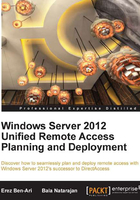
IPv6 and name resolution
Just like IPv4, IPv6 networking requires name resolution, and luckily, the Windows DNS service has been IPv6 ready for many years. IPv6-ready DNS can store name records for IPv6 resources, which is referred to as AAAA records, or Quad-A records. Modern Windows computers register both their regular addresses and their IPv6 addresses in DNS automatically, and when another computer attempts to resolve it, DNS will default to resolving the IPv6 address. The following screenshot shows the Windows Server 2012 DNS Manager, with several computers registered with both IPv4 and IPv6 addresses.

Since URA clients will be using IPv6 addresses, an IPv6-capable DNS is good to have around, so that when your corporate network computers try to connect to URA clients, DNS will help to resolve the addresses properly. One situation where things are a little more challenging is when an internal server is only capable of IPv4 traffic. This would include older operating systems, such as Windows 95, and certain devices running proprietary operating system or network stacks that haven't been updated.
To address such a situation, where the URA clients need to access an IPv4-only internal resource, the URA server role includes a function referred to as DNS64 (pronounced DNS Six-to-four) as well as another function referred to as NAT64 (pronounced NAT Six-to-four). However, it's important to know that this help can go only in one direction. This means that the IPv4-only internal server won't be able to initiate a connection to the URA client unless it is upgraded to fully support IPv6. The real-world impact of this is typically remote management. If one of your goals is remote management of remote clients, you will have to make sure that you have IPv6 capable servers for this task. Shouldn't be too hard to make this happen, right?